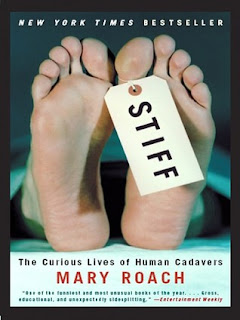Stiff: The Curious Lives of Human Cadavers by Mary Roach
"Not that there's anything wrong with just lying around on your back. In its way, rotting is interesting too, as we will see. It's just that there are other ways to spend your time as a cadaver."
From the Introduction.
I have always chosen fiction books for reading in my spare time. However, I have recently found the genre narrative nonfiction and I have a long list of books I would like to read. I read a lot of medical thrillers from authors such as: Patricia Cornwell, Robin Cook, Tess Gerritsen, and Jefferson Bass. So choosing this book as one of my first nonfiction reads was a natural choice. As a science teacher the graphic details of the human body interest me.
From the chapter "Life After Death," about forensics and embalming:
Out behind the University of Tennessee Medical center is a lovely, forested grove with squirrels leaping in the branches of hickory trees and birds calling and patches of green grass where people lie on their backs in the sun, or sometimes in the shade, depending on where the researchers put them.
This pleasant Knoxville hillside is a field research facility, the only one in the world dedicated to the study of human decay. The people lying in the sun are dead...
Many medical thrillers reference what is commonly known as "The Body Farm" so I was not surprised at all when it came up in Roach's book. This research facility is what Jefferson Bass' book series The Body Farm Novels revolves around. Jefferson Bass has also written a couple nonfiction books about The Body Farm. I highly recommend these if you enjoy his fiction books or Stiff.
The chapters that probably held the most interest for me were Dead Man Driving, Beyond the Black Box, and A Head is a Terrible Thing to Waste.
I didn't know that human cadavers had contributed so much to science and what we know now about the body and so much more. I was aware the human cadavers were used in medical school for Gross Anatomy, a class that introduces medical students to Anatomy by dissection of a human cadaver.
In Dead Man Driving, Mary Roach describes the many ways that human cadavers have been used to improve safety in automobiles. Beyond the Black Box, explains how plane crashes are studied using human cadavers and that they can determine what happened by the injuries that the bodies sustained. A Head is a Terrible Thing to Waste, explains how human cadavers are used for doctors to continue their training on something besides a live patient.
I highly recommend this book, where else can you read about cannibalism, decomposition and decapitation without reading about serial killers?
Suggestions for use in Education
I think this book would be a great addition to an Anatomy & Physiology class, it would provide insight to the history of the study of the human body that textbooks do not provide. This would also be a great choice for a Science Club to read and discuss.
A discussion guide can be found at the following link.
http://books.wwnorton.com/books/readingguidesdetail.aspx?id=13653&CID=7521&tid=3288&tcid=11201
Stiff is a New York Times Bestseller, an Alex Award, as well as being chosen for many other reader's awards.
Pub. Date: 05/17/2004 Publisher: Norton, W. W. & Company, Inc.
Lexile Reading Level: 1230L Recommended Grade Level: 9-12























